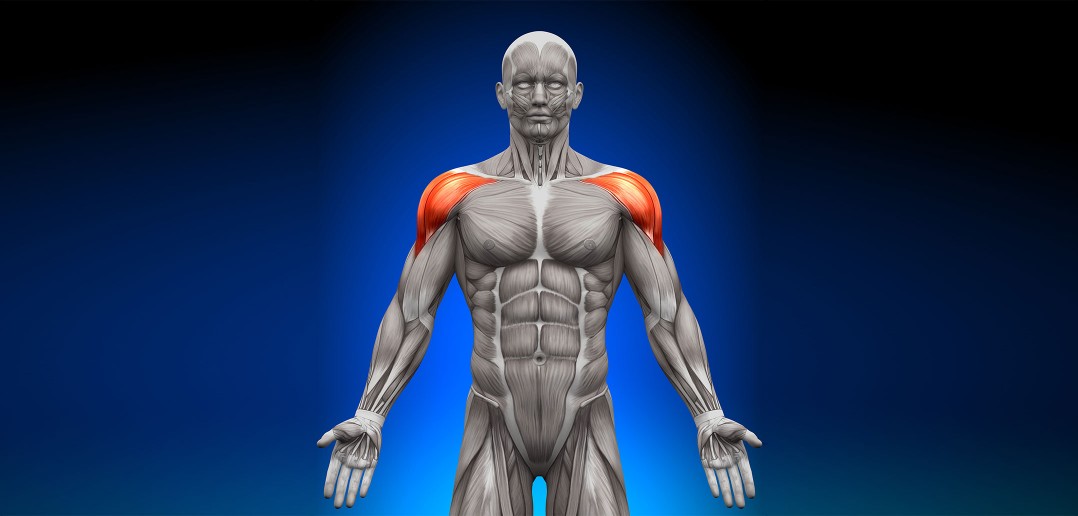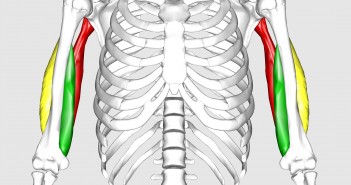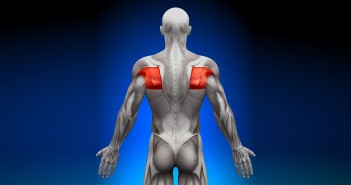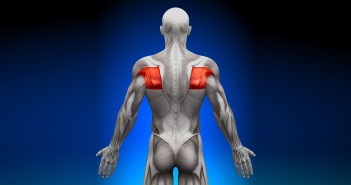The deltoid muscle is the triangular muscle forming the rounded contour of the shoulder, and the outer part of the upper arm, as it passes up and over the shoulder joint.
The wide end of the triangle is attached to the shoulder blade (scapula) and the collarbone (clavicle). The apex of the triangle is attached to the upper arm bone (humerus), about halfway down its length.
The deltoid’s strongest point is the central section, which raises the arm sideways (shoulder abduction). The front and back parts of the muscle twist (internally and externally rotate) the arm.
When the shoulder is internally rotated, lateral deltoid is involved in shoulder abduction and shoulder flexion, but it is not used significantly during strict transverse extension.
It is involved in shoulder transverse abduction when the shoulder is externally rotated.
The ligaments that connect the muscle to the bone endings are called the deltoid ligaments.
The Role of the Deltoids in the Golf Swing
Most amateur golfers try to kill the ball with their upper body strength, overpowering the swing with their large muscles, including the deltoids, in an attempt to generate high swing speeds. This almost inevitably leads to poor ball striking and shorter distances.
Accuracy and distance are gained by utilising the correct muscles, in the correct sequence, with the correct timing (see Golf Swing Sequence and Timing). It is crucial, especially with the longer clubs from the fairway, that you do not allow your upper body to dominate the golf swing.
The deltoids do, however, play a very important role in the golf swing. Your arms move through a large range of motion, while your torso remains relatively stable. Your shoulders and back must remain in proper posture in order to support optimal shoulder movement and rotation of your spine.
Mobility and strength in your deltoids helps to support this movement, enabling you to more efficiently achieve the appropriate angles within the swing, leading to better and more consistent ball striking and decreased risk of injury.
You must maintain proper arm and shoulder angles to prevent releasing the golf club early in the downswing. This requires more strength and stability as the length of the golf club increases. With the longer clubs, especially, shoulder control and stability is crucial for good swing technique.
Creating and holding angles in the golf swing, creating lag, is beneficial only if you can release those angles efficiently. Late in the downswing, these angles must be released effectively to pass the energy from your torso to your arms and then to the golf club. The deltoids help to transfer the energy from your torso to your arms and prepare it to enter the club, they help to stabilise your shoulder complex and work in concert with the muscles of your core. Increasing the strength in your deltoids enables you to create more lag and therefore more power in your swing.
Most shots in golf do not require immense amounts of upper body strength and power, but when playing out of thick rough you need to drive the club head through the thick grass. The deltoids help to generate the club head momentum required to do this. At times like this, strong deltoids become extremely important for your shot-making potential. They enable you to drive through the rough without losing much club head speed or club stability, while still creating enough ball compression to generate some spin on the ball. You will be able to get back to the fairway much more easily, and you will also have more opportunities to go for the green from a terrible lie.
The deltoids also play an important role in decelerating your arms later in the golf swing. Deceleration is very important in golf, as it allows for stabilisation and the transfer of energy all the way to the club head.
If you have any questions or comments about this or other articles on Golf Loopy, please send us an email.
You May Also Like…
Overview of a Great Golf Swing, which summarises the correct movements in a great golf swing.
An overview of the golf swing kinematic sequence, including a detailed analysis of the Downswing phase in Golf Swing Sequence and Timing.
Golf Swing Sequence and Timing – Common Faults, which gives a comparison of the kinematic sequence for typical amateurs and Tour Pros, showing the common flaws that may plague your own golf swing.
Golf Lag and the Compound Pendulum, which describes how you can use physics to generate more speed, accuracy and consistency in your golf swing, with less effort and less strain on your body.
The Role of the Right Arm in the Golf Downswing, which describes how the right arm transfers energy to the golf club in the downswing.
Is the Golf Swing Powered by the Arms?
Why is Having the Shoulders “Connected” So Important? Which explains how the shoulders enable the power of the big muscles in your legs and core to be transferred to the golf club.
Golf Anatomy and Kinesiology, a collection of articles describing the roles of the muscles involved in the golf swing.
Kinetic Chain, which describes how the different parts of your body act to transfer energy from the ground to the golf ball.
Internal and External Rotation, which describes the rotation of the right arm in the golf swing, and how to increase your range of motion.
Core muscles, which describes the muscles that run the length of your trunk and torso.
The Role of the Teres Minor in the Golf Swing.
The Role of the Triceps in the Golf Swing.




